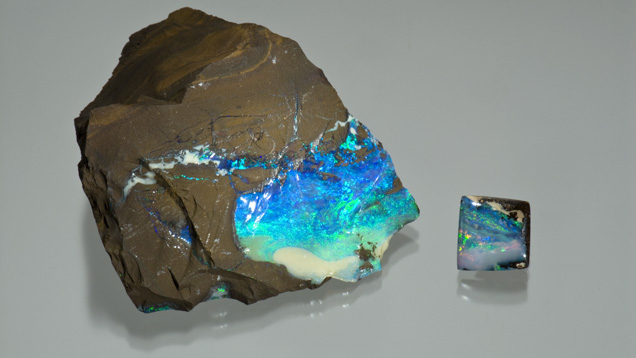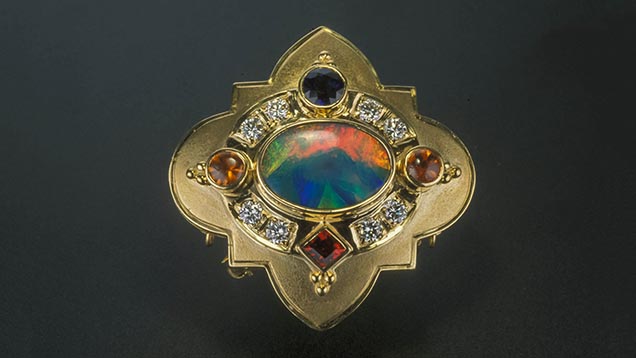Opal

In 75 AD, the Roman scholar Pliny observed, “Some opali carry such a play within them that they equal the deepest and richest colors of painters. Others…simulate the flaming fire of burning sulphur and even the bright blaze of burning oil.” He marveled that this kaleidoscopic gem encompassed the red of ruby, the green of emerald, the yellow of topaz, the blue of sapphire, and the purple of amethyst.
Many cultures have credited opal with supernatural origins and powers. Arabic legends say it falls from the heavens in flashes of lightning. The ancient Greeks believed opals gave their owners the gift of prophecy and guarded them from disease. Europeans have long considered the gem a symbol of hope, purity, and truth.
Opal is considered an October birthstone. Some people think it’s unlucky for anyone born in another month to wear an opal. But that particular superstition comes from a novel written in the 1800s (Anne of Geierstein by Sir Walter Scott), and not from any ancient belief or experience. In fact, throughout most of history, opal has been regarded as the luckiest and most magical of all gems because it can show all colors. Once, it was thought to have the power to preserve the life and color of blond hair.
 Opal is the product of seasonal rains that drenched dry ground in regions such as Australia’s semi-desert “outback.” The showers soaked deep into ancient underground rock, carrying dissolved silica (a compound of silicon and oxygen) downward.
Opal is the product of seasonal rains that drenched dry ground in regions such as Australia’s semi-desert “outback.” The showers soaked deep into ancient underground rock, carrying dissolved silica (a compound of silicon and oxygen) downward.How Opal Forms
Opal is known for its unique display of flashing rainbow colors called play-of-color. There are two broad classes of opal: precious and common. Precious opal displays play-of-color, common opal does not.
Play-of-color occurs in precious opal because it’s made up of sub-microscopic spheres stacked in a grid-like pattern—like layers of Ping-Pong balls in a box. As the lightwaves travel between the spheres, the waves diffract, or bend. As they bend, they break up into the colors of the rainbow, called spectral colors. Play-of-color is the result.
 Although experts divide gem opals into many different categories, five of the main types are:
Although experts divide gem opals into many different categories, five of the main types are:- White or light opal: Translucent to semitranslucent, with play-of-color against a white or light gray background color, called bodycolor.
- Black opal: Translucent to opaque, with play-of-color against a black or other dark background.
- Fire opal: Transparent to translucent, with brown, yellow, orange, or red bodycolor. This material—which often doesn’t show play-of-color—is also known as “Mexican opal.”
- Boulder opal: Translucent to opaque, with play-of-color against a light to dark background. Fragments of the surrounding rock, called matrix, become part of the finished gem.
- Crystal or water opal: Transparent to semitransparent, with a clear background. This type shows exceptional play-of-color.
 03 9642 3649
03 9642 3649 